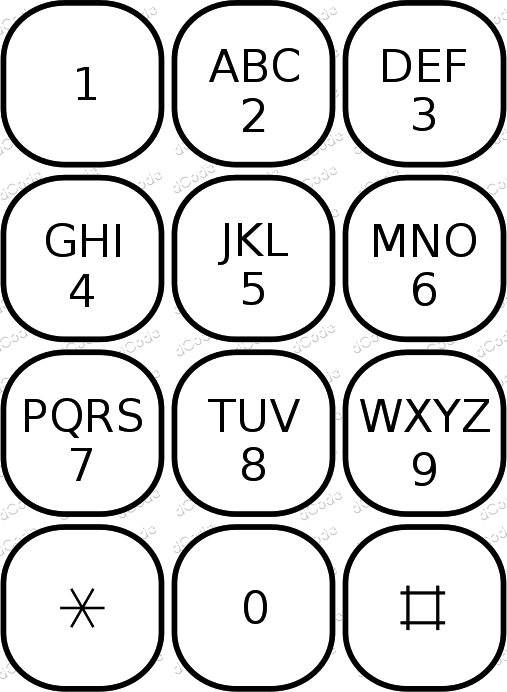Tool to decrypt/encrypt messages with a mobile phone keypad. (Old) Phone keypads allow you to write messages in several ways: Multi-tap, ABC code, T9 code, Vanity, etc. and can be used as a cipher.
Phone Keypad Cipher - dCode
Tag(s) : Telecom, Substitution Cipher
dCode is free and its tools are a valuable help in games, maths, geocaching, puzzles and problems to solve every day!
A suggestion ? a feedback ? a bug ? an idea ? Write to dCode!
Phone Keypad Cipher
ABC or Multi-tap Code
The Multi-tap code is the name given to the telephone input technique that consists of writing a letter by repeating the corresponding key on the mobile phone keypad.
2 for A, 22 for B, 222 for C, 3 for D, and so on.
CODE is written 222-666-3-33.
dCode has a tool for that:
T9 Code (Predictive text)
T9 code is the name given to the prediction algorithm that uses a dictionary to guess the word the user is trying to write. For example: 2 for A or B or C, 222 for BAC or ABC.
CODE is written 2633.
dCode has a tool for that:
Answers to Questions (FAQ)
What are phone keypad codes? (Definition)
Phone keypad codes are the methods for writing text using the keys on a phone keypad (numbered 0 to 9, sometimes with * and #).
There are mainly 2 modes for entering text in the absence of a full keyboard:
— the ABC or Multi-tap mode on the one hand, which allows you to write a character by repeating a key
— the T9 mode on the other hand, which uses a dictionary to obtain intuitive input and avoid repeating keys.
On the same old model of mobile phone, these modes can coexist but are incompatible.
What is the configuration of the keys on a phone keypad?
How to recognize T9 mode?
T9 has short numbers, whose length (number of digits) is equal to the number of letters in the word.
Example: MESSAGE=6377243
There is little repetition of the same digit.
The digit 1 is rarely used.
The input is minimal and fast (only 1 press per key) for each letter and encourages typing SMS without abbreviations.
How to recognize ABC mode?
The ABC multitap has long numbers (often much longer than the original word)
Example: MESSAGE=633777777772433
There are many repetitions of consecutive numbers (corresponding to successive presses of the same key).
The number 1 is rarely used.
This is the historical and tedious method that led to the use of many abbreviations in writing SMS.
What is the Vanity code?
Vanity is a technique of personalizing phone numbers by using letters associated with numbers to form memorable words or phrases (sometimes called Phonewords).
Vanity code is the name given by the Anglo-Saxons to the codes above. Some give it for the T9 mode, others for the ABC/Multitap mode.
Source code
dCode retains ownership of the "Phone Keypad Cipher" source code. Any algorithm for the "Phone Keypad Cipher" algorithm, applet or snippet or script (converter, solver, encryption / decryption, encoding / decoding, ciphering / deciphering, breaker, translator), or any "Phone Keypad Cipher" functions (calculate, convert, solve, decrypt / encrypt, decipher / cipher, decode / encode, translate) written in any informatic language (Python, Java, PHP, C#, Javascript, Matlab, etc.) or any database download or API access for "Phone Keypad Cipher" or any other element are not public (except explicit open source licence like Creative Commons). Same with the download for offline use on PC, mobile, tablet, iPhone or Android app.
Reminder: dCode is an educational and teaching resource, accessible online for free and for everyone.
Cite dCode
The content of the page "Phone Keypad Cipher" and its results may be freely copied and reused, including for commercial purposes, provided that dCode.fr is cited as the source.
Exporting the results is free and can be done simply by clicking on the export icons ⤓ (.csv or .txt format) or ⧉ (copy and paste).
To cite dCode.fr on another website, use the link:
In a scientific article or book, the recommended bibliographic citation is: Phone Keypad Cipher on dCode.fr [online website], retrieved on 2025-04-15,

